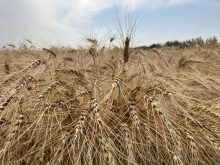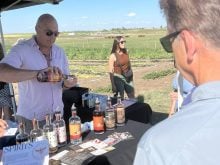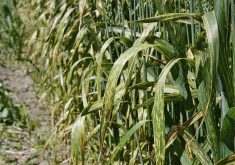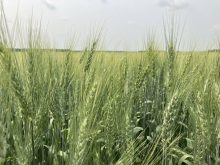The farming life can be a lonely one, and it’s all too easy to forget you’re part of a large network bringing food to the tables of families around the world.
But that realization strikes producers who have taken the Combine to Customer course put on by Cereals Canada.
“I now have a whole new appreciation of what happens with that kernel of wheat when we’re done with it and all the diligence that goes on afterward to ensure that we have a market to move our commodity to,” Vermilion farmer Shawn Jacula said from Winnipeg’s airport on his way home late last month.
Read Also

Moo translator and methane measures: There’s an app for that
Dalhousie University researchers use artificial intelligence to create new dairy farm apps that analyze cattle sounds and measure methane.
“I’m just still absorbing it all.”
Combine to Customer, held every February and March in Winnipeg, covers topics such as key qualities of wheat classes, the current market outlook and grain grading demos.
“You go into it thinking wheat is wheat is wheat — and you find out that’s not the case,” Greg Sears says in a new video promoting the program.
The Sexsmith-area farmer, who took the course in 2019, said he also has a new appreciation for “all the work that goes into developing markets” and maintaining them.
“It really broadens a farmer’s perspective on the value chain and what happens to our wheat and barley once we leave them at the elevator,” he said in an interview.
Sears learned the “value chain” isn’t so much a chain as a series of loops where parties on one part of the continuum strategize meticulously with others.
“What you learn is the development process: how breeding takes place, how certain older varieties are cross-bred to produce the newer varieties, the registration process for new varieties, testing, and the collaborative effort that happens between the plant breeders, the marketing companies and the Canadian Grain Commission to make sure that all new varieties are consistent with what our markets expect,” he said.
The course covers how different varieties of wheat have evolved over the years to adapt to new markets and changing tastes.
“All along there’s checks that make sure that milling wheat still meets customer needs for bread making or noodle making,” said Sears, who is now chair of the Alberta Wheat Commission.
“It highlights the diversity of what you might perceive as a homogeneous crop of wheat; the different varieties, classifications and quality going to different end products, whether it’s noodles or pan breads or flat breads. All over the world there’s different uses for our product.”

The sheer reach of Canadian wheat products worldwide surprised Sears.
“The number of countries we export to is really a staggering statistic.”
It also gave him a better understanding of global tastes and policies.
“It highlights the importance of such things as using crop protection products properly, using registered varieties of crops, and maintaining the quality of what you produce and how important that is to the supply chain.”
Jacula, Alberta Wheat’s second vice-chair, said he was pleased to learn about the importance of falling numbers (a high falling number is a sign of good dough elasticity) in the bread making process.
“Falling number was a hot topic a couple of years ago but I think I didn’t quite understand the severity of that to the production of mainly bread,” he said. “That was something that was eye-opening for sure.”
He was also happy to see such a diversity of people —in terms of geography and what they bring to the value chain — at the event.
“If I have a concern or a challenge on a certain topic, I’ve just expanded my range of people that I can reach out to, to help me and my operation,” said Jacula.
The program has been around for years but people usually learn about it from past attendees.
“There’s been lots of chatter about how good of a course it was — and being somebody who just became an alumni of it, I fully agree,” said Jacula.
“I have several friends and neighbours who have gone on it and spoke highly of it. The timing never really worked out for me until a couple of years ago when I was finally able to go.”
The video can be found at the Cereals Canada YouTube channel.
















